Looking for a Sumatra travel guide for solo women over 50? Here it is!
Picture an idyllic Indonesian island blanketed with tropical rainforests, strewn with volcanoes, bursting with unique cultural experiences, and offering almost every stunning landscape you can imagine – from rice paddies and dense jungles to white-sand beaches and smouldering peaks.
Perhaps Bali came to mind, but no, think a little bigger – about 81 times bigger – and you’ll be envisioning the vast, wild, enticing island of Sumatra, a place you must try to come to when you visit Indonesia.
This Sumatra travel guide will show you that Sumatra Island is a slightly off-the-beaten-path destination – although in some areas, you cannot even see the path!
If this is your first solo trip, the Sumatra holidays might seem a bit daunting.
But if you’re a solo woman who has traveled alone before and is ready to step a little outside your comfort zone, visiting Sumatra is a great idea. You can mix comfort with a touch of adventure, or go completely intrepid; the choice is yours.
And please – don’t forget your travel insurance before you go! Two outstanding insurers are for travelers are Visitors’ Coverage and SafetyWing – whoever you choose, make sure you get insurance for any trip abroad.
First time in Sumatra
Like many people, I knew little about Sumatra when I embarked on my first solo trip. I knew there were jungles and orangutans, but with zero experience travelling outside Australasia, I was more than a little apprehensive.
Fast forward a decade, with many trips to Sumatra behind me, I now live in Sumatra with my local husband. Needless to say, as a solo female traveller, Sumatra not only captured my imagination and my heart, but also changed my life.
Sumatra is an incredible place for solo travellers of all ages. While it has a reputation for being an adventurous place, even less intrepid travellers will find it captivating.
The island of Sumatra in Indonesia is still relatively unknown to casual tourists. It sits in the Indian Ocean north of Java, where Jakarta, Indonesia’s capital, is located. Malaysia is to the east, and the island’s largest city, Medan, is a mere hour’s flight from the major transport hubs of Singapore and Kuala Lumpur.
As you can see, Sumatra isn’t particularly difficult to reach.
Top things to see in Sumatra
Any worthwhile Sumatra itinerary will make sure it includes the following.
The wildlife
Sumatra’s biggest attraction is its endemic wildlife, with Sumatran orangutans being the biggest drawcard.

This is the only place in the world where you can see Sumatran orangutans in the wild. Their remaining populations are only found in Gunung Leuser National Park, which covers parts of North Sumatra and neighbouring Aceh. Spend your time in Sumatra in touch with nature – exploring wildlife is one of the best things to do in Sumatra.
In fact, the Gunung Leuser Ecosystem is the last habitat in the world where orangutans, rhinos, elephants and tigers roam in the same jungle – although their chances of running into one another are highly unlikely.
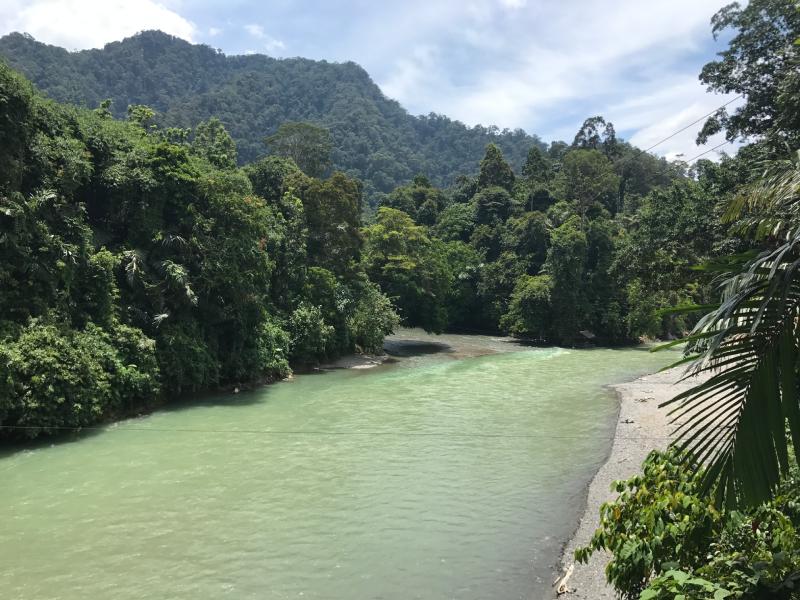
In addition to these mega-fauna, trekking in Sumatra will uncover plenty of other plants and animals, from the endemic “funky monkeys” (Thomas Leaf Monkeys) and stunning hornbill species to the largest (and smelliest) bloom in the world, the rafflesia (or corpse flower).
The culture
There is no shortage of ethnic diversity in Sumatra. Indonesia is made up of more than 300 different cultures, and Sumatra, one of 6000 inhabited islands, has at least 20 different ethnic groups.
Each region has its own unique ethnic group, and often more than one. Each culture has its own language, dress, music, and traditions, from the Gayo in Aceh and the Batak in North Sumatra to the unique tribal societies in the Mentawai Islands.
For those looking to expand their cultural horizons, Sumatra is an excellent place to start.
Must-try Sumatra food
Indonesian food is famously delicious, with standard dishes like nasi goreng (fried rice) known worldwide. But Sumatra food is famous even within Indonesia!
Many of its mouthwatering offerings come from Padang in West Sumatra, including rendang – a rich, flavoursome meat dish slow-cooked in coconut milk and seasoned with herbs and spices.
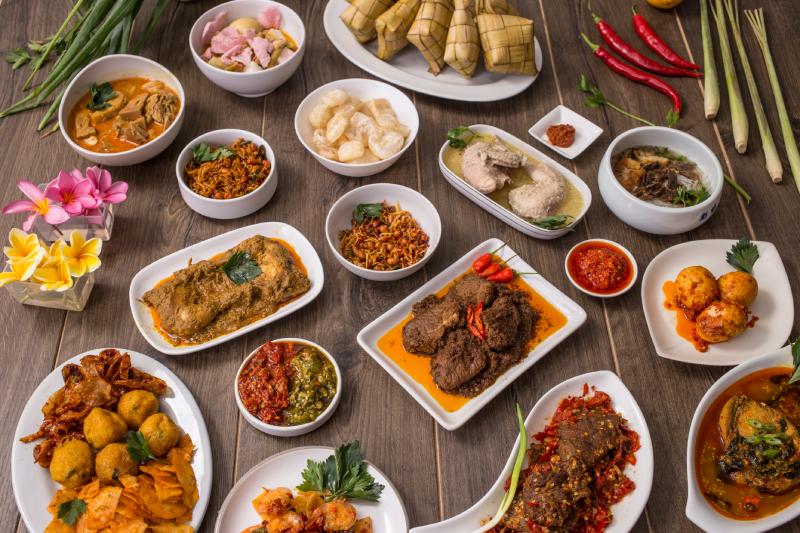
Sumatran food is renowned for its spiciness, so those who like their food with a kick will be in foodie heaven. But there are plenty of tasty morsels for those with more sensitive palates, including the peanut-sauce-covered vegetarian dish Gado Gado and a range of curries, noodle, and rice dishes.
The landscapes
The landscapes of Sumatra are as diverse as its peoples. Craving a beach holiday with some laid-back snorkelling? Plenty of Sumatra islands to choose from.
Heading into the jungle in search of incredible wildlife? Take your pick of Sumatra national parks.
Hiking up an active volcano? Or just relaxing in a natural hot spring beneath one? Can do.
Pristine rivers and waterfalls, rolling green hills and farmland, or sparkling lakes surrounded by mountains – all lie in wait when you travel in Sumatra. The only things you won’t find here are snow-capped peaks or glaciers.
The climate
Sumatra is larger than many countries (approximately the size of Thailand and slightly larger than Sweden – or California). So it’s no surprise that the weather is variable, depending on where you go. But overall, Sumatra climate is lovely and warm. Temperatures throughout the day tend to sit between 27 and 32 degrees Celsius (80-90 degrees Fahrenheit). They remain consistent year-round because the equator slices through the island’s center.
There’s a wet and dry season, but weather patterns are increasingly unpredictable, thanks to climate change. While there’s no dramatic monsoon season to consider when planning, the wet season can hamper outdoor activities.
Regions can differ, but generally, island-wide, the best time to visit Sumatra is between May and August.
Here are details about the best time to visit Sumatra, with regional data and month-by-month information.
Sumatra travel planning – getting around Sumatra
One of the most challenging aspects of Sumatra travel is the distance between popular locations.
Thoroughly exploring just one of the eight provinces (detailed in the following section) could take you months – an enticing adventure for travellers with plenty of time on their hands but a conundrum for those with a more limited schedule.
This map of Sumatra will give you an idea of the location of Sumatra and its diversity.
You have two options when travelling Sumatra: save money and take it slow, or increase your budget to speed things up a little.
Flying in Sumatra
Sumatra tourism is easiest by airplane – but also most expensive. Flights between provinces (and some small offshore islands) are fast and frequent, and a flight between Sumatra and Java will take just over two hours. They used to be very affordable, but things haven’t returned to normal post-COVID, so flights aren’t as budget-friendly as they once were.
If you have a more generous budget, spend extra to fly longer distances in order to spend more time exploring.
However, you don’t have to fly if you don’t want to.
Travelling by bus in Sumatra
Long-distance, overnight buses travel between provinces and major cities. For example, from Medan City in North Sumatra to Banda Aceh in Aceh will take around 12 hours. The trip from Medan to Padang requires more stamina at around 21 hours.
Most of these long-distance buses are comfortable, with air conditioning, reclining seats, and toilets. Book with A.L.S or Pelangi for the most bearable trip – schedules and booking details are available through Traveloka.
Bear in mind that shorter or cheaper bus trips may be a little less comfortable. The smaller local buses (called angkot) are more like vans. They are usually packed full of people (and sometimes goods and animals), with no air conditioning. You might also find yourself contending with loud disco music (called dangdut) and thick cigarette smoke.
Hiring a car in Sumatra
The middle ground between bus and plane travel is to hire a car with a driver. Yes, you could hire a car and drive it yourself, but you should avoid this.
Sumatran roads are chaotic and dangerous. Unless you’re accustomed to this type of driving, get a car with a driver; it’s much safer, you can stop where you like, and you get the pleasure of being accompanied by someone with insider knowledge of the places you’re passing through.
Ride-sharing apps in Sumatra
Grab and Gojek are wildly successful ride-sharing apps in Indonesia. Unfortunately, these services only really operate in larger cities and towns, but where they are available, they are essential.
Grab works like Uber, finding you a car and driver, supplying you with an exact price, and tracking your journey. Gojek is similar but gives you the option of motorcycle or car trips. Motorcycles are a very popular way of travelling in Sumatra, so if you drive, renting a motorcycle is a good way to go around too. Additionally, Gojek has utilities that allow you to order food, groceries, or even medicine to your hotel.
Sumatra travel guide: things to see and do
Sumatra is divided into seven provinces and one autonomous province (Aceh).
- Aceh
- North Sumatra
- Jambi
- Riau
- West Sumatra
- South Sumatra
- Bengkulu (with some of the best Sumatra beaches)
- Lampung
Each province warrants an entire article of its own, but this is a basic Sumatra travel guide so we’ll concentrate on the highlights of Sumatra Island.
1. Pulau Weh, Aceh
Pulau Weh (Weh Island) is an idyllic tropical island off the northernmost coast of Sumatra.
It can be reached by fast ferry (around 45 minutes) or slow ferry (about 90 minutes) and is well worth a visit if you’re a beach lover or interested in diving and snorkelling.
At just 156 sq km, Pulau Weh is a great little spot to spend a few days. You can enjoy some of the most scenic beaches in Sumatra, explore the coastline by scooter (the roads are safe and quiet) and visit the monument at Kilometer Nol – designated the most northern point of Indonesia.
The sea around Pulau Weh is a protected area, which makes it perfect for snorkelling and diving. Explore the shoreline around Iboih Beach or hop across to the gorgeous coral garden at Rubiah Island. You can even swim and snorkel at an active underwater volcano!
If you pass through Banda Aceh, visit the Tsunami Museum. It is a sobering reminder of the 2004 Sumatra earthquake that caused a giant tsunami in which 170,000 people were killed. You can also see how the province was rebuilt following the tragedy. (Ed. note: Aceh is a deeply Muslim province and the only one in Indonesia to be ruled by Sharia law. Please act and dress accordingly.)
2. North Sumatra
North Sumatra is home to Sumatra’s largest city, Medan (its airport, Kualanamu, is the entry point for most international travellers). Medan itinerary and sightseeing will probably not be high on your list − it isn’t the prettiest of cities; it’s somewhat chaotic, muggy, and polluted. But it is full of life, and an excellent place to spend a night when you arrive in (or before you leave) Sumatra.
Aside from the city, this province is rich with attractions, and your North Sumatra itinerary will be bursting with things to do.
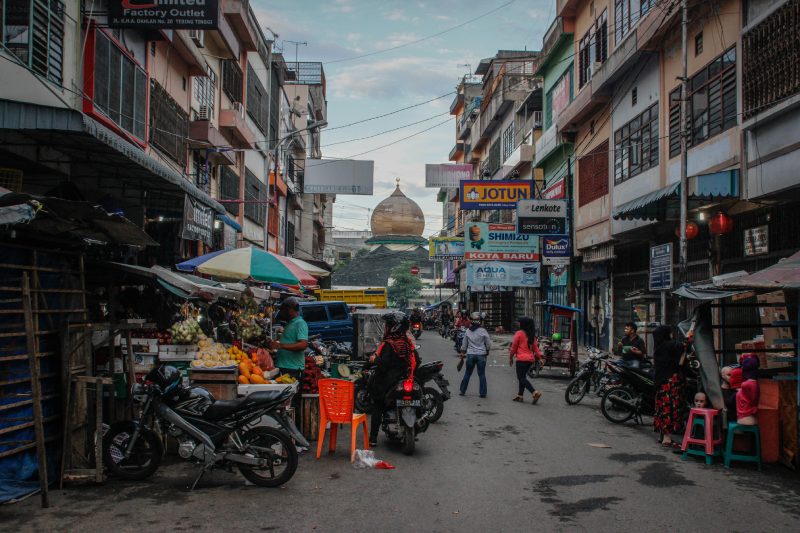
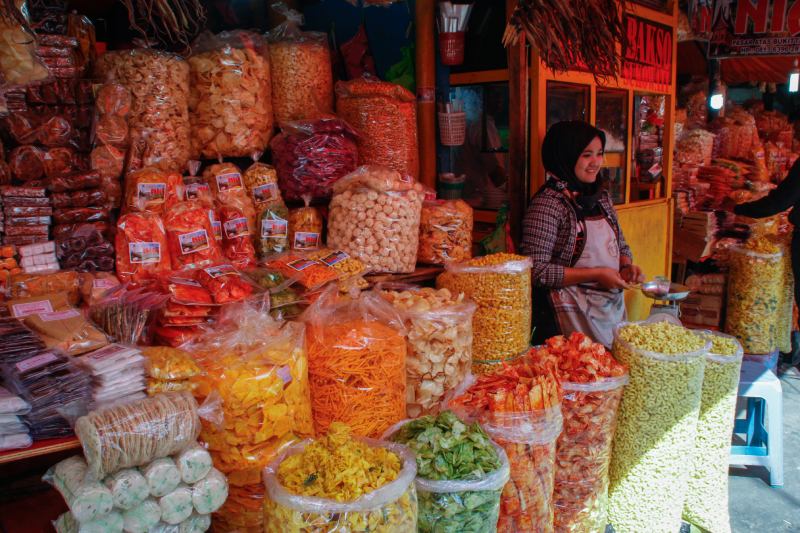
There’s much to see and do, so here’s a brief North Sumatra travel guide.
Jungle trekking at Bukit Lawang
Around three hours west of Medan lies the reason many people visit Sumatra and the heart of North Sumatra tourism: Bukit Lawang, a bustling little village on the edge of the river, bordering Gunung Leuser National Park. It’s one of the most popular places to visit in Sumatra, and part of any Sumatra backpacking route.
Once a sanctuary and release site for endangered Sumatran orangutans, it’s now a popular tourist attraction and probably your best bet for seeing wild (or often, semi-wild) orangutans. As it’s surrounded with rich Sumatra jungle, you’ll also see plenty of other amazing flora and fauna.
Unfortunately, not every tour company or guide based in Bukit Lawang is ethical, so it’s important to do your homework and ensure you invest your money with businesses that don’t feed or approach the orangutans. Find out why that’s so important with this guide to choosing an ethical Sumatra guide in Bukit Lawang.
It’s also worth noting that there are other options for orangutan trekking in North Sumatra and Aceh. Close to Bukit Lawang, you have two small, authentic villages bordering the jungle – Batu Katak and Tangkahan.
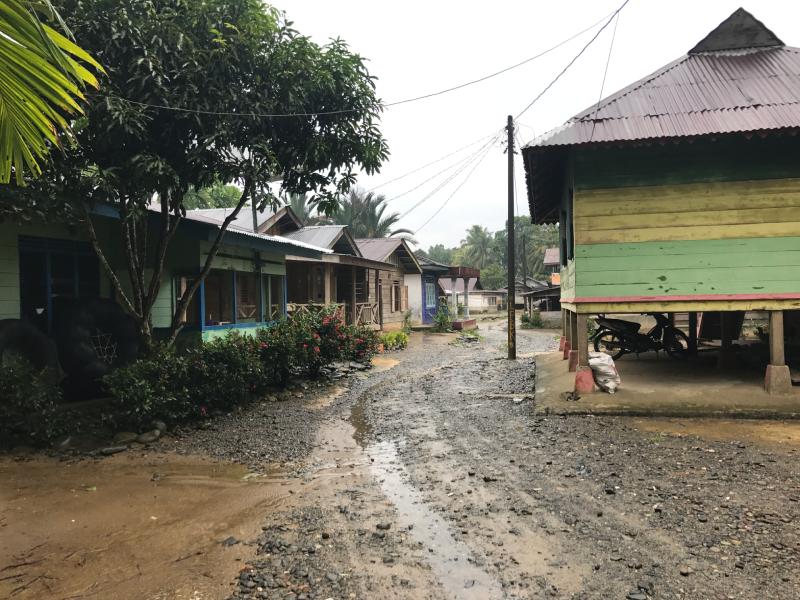
If you’re willing to go further afield, Ketambe (in Aceh, the neighboring province to the North) is a fantastic off-the-beaten-path location and jumping-off point for Sumatra jungle trekking. These places don’t offer the same high chances of seeing wild orangutans as Bukit Lawang, but the orangutans are generally wilder and exhibit fewer unnatural behaviors.
Relax at Lake Toba
Is Lake Toba worth visiting? If you fancy exploring an island in the middle of the world’s largest crater lake, it totally is. Visit Samosir Island in Lake Toba, a four-hour drive (and a 30-minute ferry ride) from Medan.
One of the top places you should visit on your Sumatra trip, this incredible island brings to mind visions of Switzerland, with towering volcanic cliffs curving into the massive lake.
This region is home to the Batak Toba people (one of six Batak indigenous groups in Sumatra). You’ll find the characteristic, enchanting Rumah Bolon (traditional Batak houses) throughout the Toba area, as well as plenty of cultural sites to visit to learn about their history and customs.
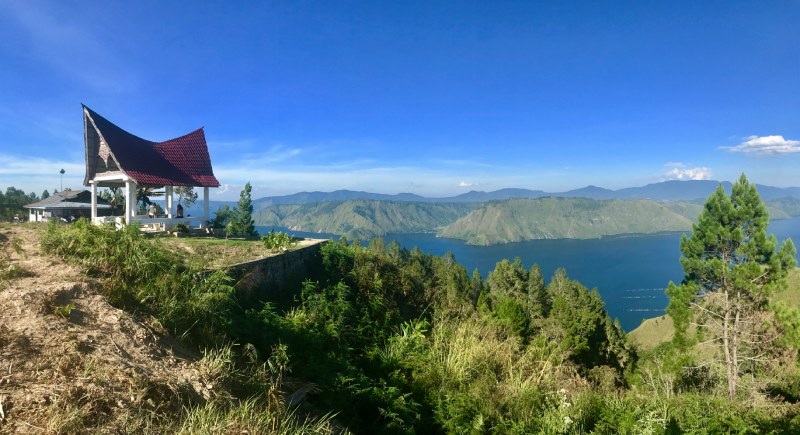
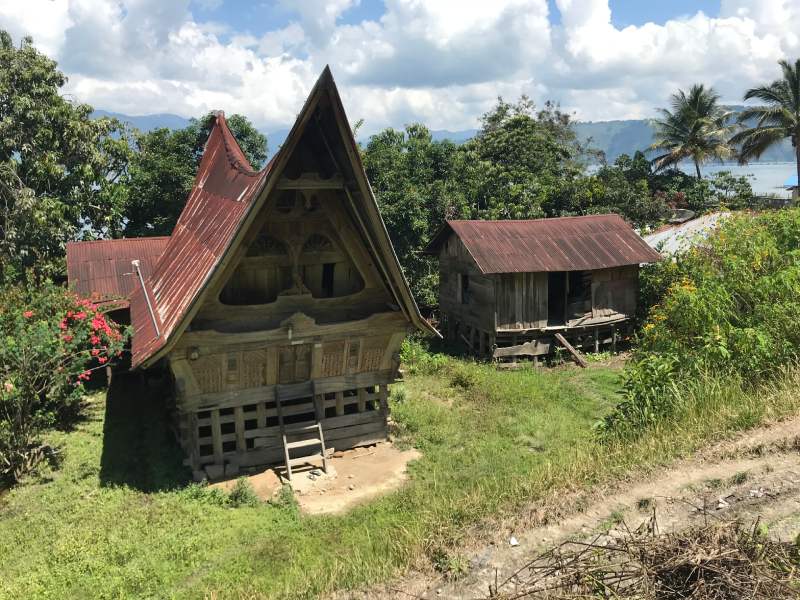
Lake Toba is the place that cemented my love for Sumatra. After a month in the middle of the jungle, I spent time here and instantly fell in love with the climate, the scenery, the music, and the people.
Years of visits later, this is now my home base, and I can’t imagine a better place to live. Here’s an in-depth guide to Lake Toba so you can read up before you go.
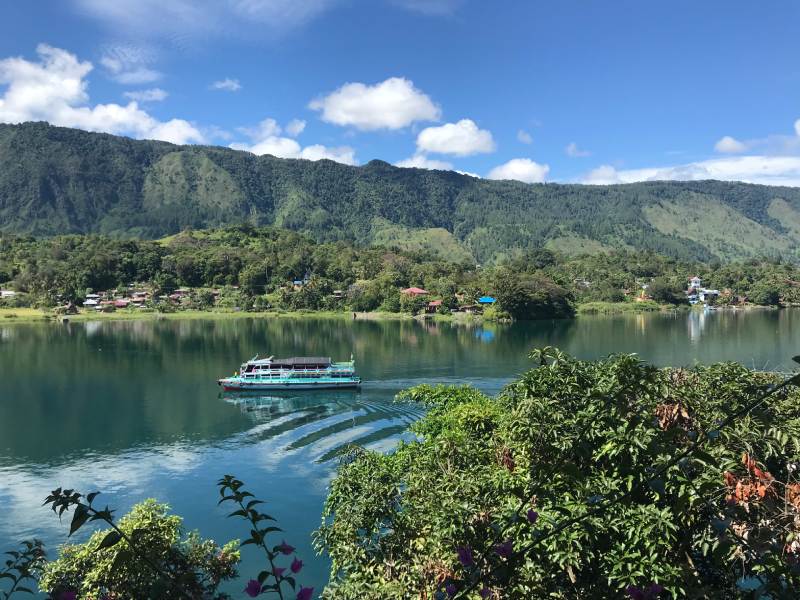
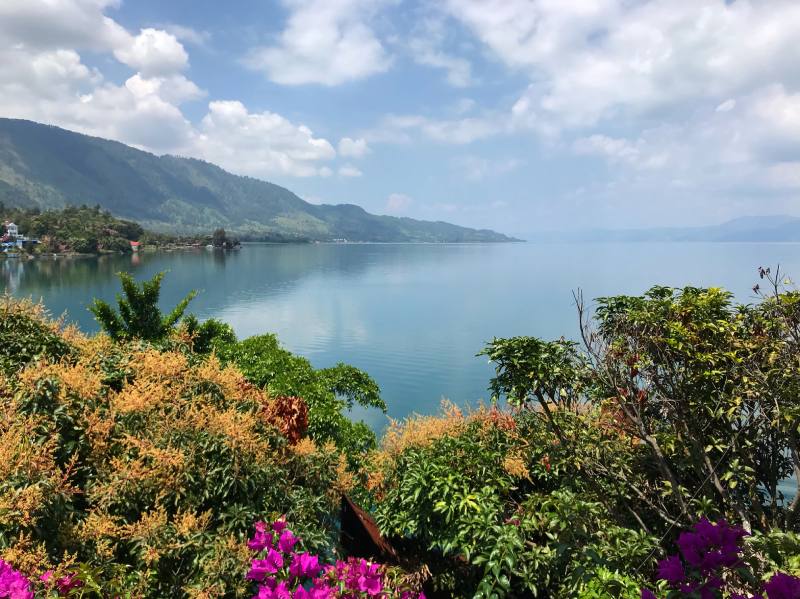
Samosir is a large island, around the size of Singapore, but it’s well worth spending at least 3-4 nights here on your North Sumatra itinerary.
Hire a scooter, head up into the hills, explore the Batak museums, take a cooking class, kayak around the lake, visit the hot spring, take a boat tour… you’ll be lost for choice.
More notable North Sumatra attractions for your Sumatra travel itinerary
- Berastagi: Enjoy a cooler climate in this higher-altitude farming area. Check out the mouthwatering fruit and vegetable market or hike up Mount Sibayak to get views of the still-active (and too dangerous to hike) Mount Sinabung.
- Sipisopiso Waterfall: If you’re heading to Berastagi or Lake Toba, stop in to marvel at one of Indonesia’s largest waterfalls.
- Tangkahan: there are plenty of free, safe, easy things to do in Sumatra, so even if you’re not up for a jungle trek, this jungle village is worth visiting. The river is perfect for swimming; there are waterfalls to wash your hair in right beside the village and even a hot spring cave to soak in. Visit the elephant sanctuary to stroll with the elephants on the edge of the jungle (no riding allowed), and if you feel up to it, float down the river on a tube to eat a picnic lunch at a scenic waterfall.
And finally – if you’re wondering is North Sumatra safe – the answer is yes! The north is the most visited part of Sumatra island, so its tourist facilities are better developed than in the rest of the island.
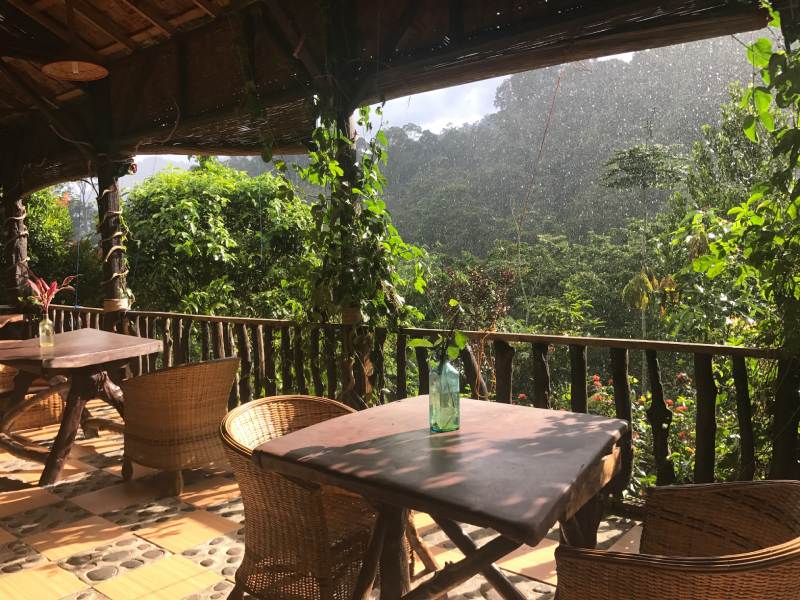
3. West Sumatra
West Sumatra travel may not be as popular as visiting the north, but it’s definitely worth a visit if you love Indonesian food. Explore Padang, a foodie’s paradise, for some wonderful meals.
Head over to Bukittinggi to see the stunning Lake Maninjau and then visit the Harau Valley. Lush, green, and dwarfed by cliffs, this is the ideal site for a gentle bicycle ride or a tour by car.
Appreciate the gorgeous architecture of the Minangkabau people and learn about their culture.
For a trip back in time, and some real cultural immersion, visit the indigenous hunter-gatherer tribes of the Mentawai Islands. You’ll need to set aside at least a few days for this trip, and you must visit with a guide.
4. South Sumatra
South Sumatra tourism may not be as developed as in the North, but it’s definitely worth the time of any adventurer.
Palembang is one of the oldest cities in Southeast Asia and is located in the in the central part of South Sumatra, on the Musi River. After visiting, explore the surrounding areas, full of waterfalls and tea and coffee plantations.
Spend some relaxing time at Lake Ranau or go birdwatching at Sembilang National Park.
5. Sumatra holiday destinations: Sumatra islands
Sumatra has more than one hundred islands within its territory (the Mentawai Islands alone comprise 70!)
While some are accessible and offer home comforts, others are more remote and provide back-to-basics, pristine off-the-grid experiences.
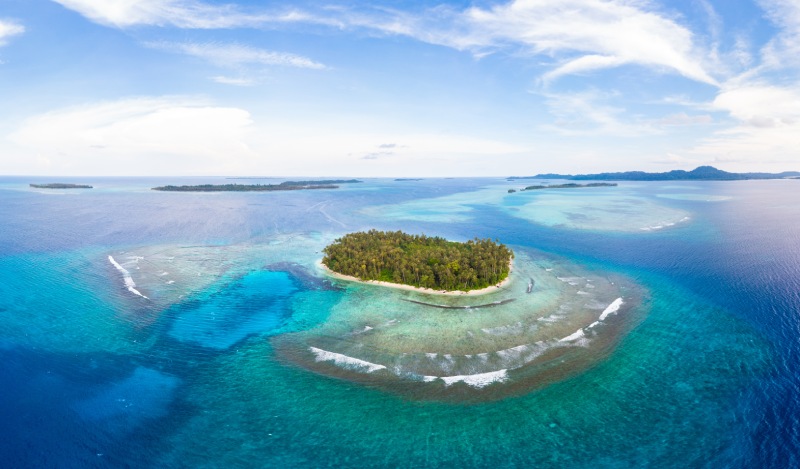
Your Sumatra holiday should include at least a few visits to the beach.
In case you’re still wondering where to go and what to do in Sumatra, the surrounding islands hide some of the best beaches Sumatra has to offer, along with plentiful Sumatra wildlife.
Here are some top areas to visit I haven’t mentioned yet:
- Nias (North Sumatra) – for surfing and spotting sea turtles. Where is Nias? It’s a large island off the western shore of North Sumatra.
- Belitung (near South Sumatra) – for dining, shopping, and sunbathing
- Bintan (a Riau Island) – for resorts, spas, and golf clubs
- Banyak Islands (Aceh) – for an entire Sumatra beach to yourself and getting away from it all
- Banana Island (Southern Sumatra) – for eating coconuts and watching the local fishermen bring in their catch of the day
What is life in Sumatra like?
While Sumatra is in the same country as Bali, the two islands are worlds apart. Most of Bali is dedicated to international tourists, and it’s very easy to make yourself comfortable there.
Sumatra certainly has areas that offer plenty of home comforts – and even some genuine luxury – but overall, this isn’t a luxury travel destination.
Other than a handful of tourist spots, the places you might visit are likely to be basic, but therein lies the attraction for people that have fallen for Sumatra (like myself).
For me, this is a land of small villages with roughshod bamboo or wooden Sumatra houses and dusty roads. People gather in small warungs (simple cafés or coffee houses) to chat throughout the day and into the evening.

Chickens, dogs, goats, and cows roam freely through the villages and snooze in the middle of bumpy gravel roads, reluctant to move for any vehicles that pass.
Many people have small shops or petrol stands out in front of their homes, selling the petrol in one-liter recycled water bottles.
Community living is the norm – families live in the same house or next door to one another, and childcare is a shared effort, much as you’ll find in Borneo.
Someone is always strumming a guitar and singing (usually quite beautifully – it seems most people in Sumatra are born singers), and people gather in the evenings to sing together and drink coffee or tuak (palm wine).
Dishes are served and enjoyed while sitting on a mat on the floor. Families and friends sit cross-legged and share rice, vegetables and flavoursome curries, eating with their hands.
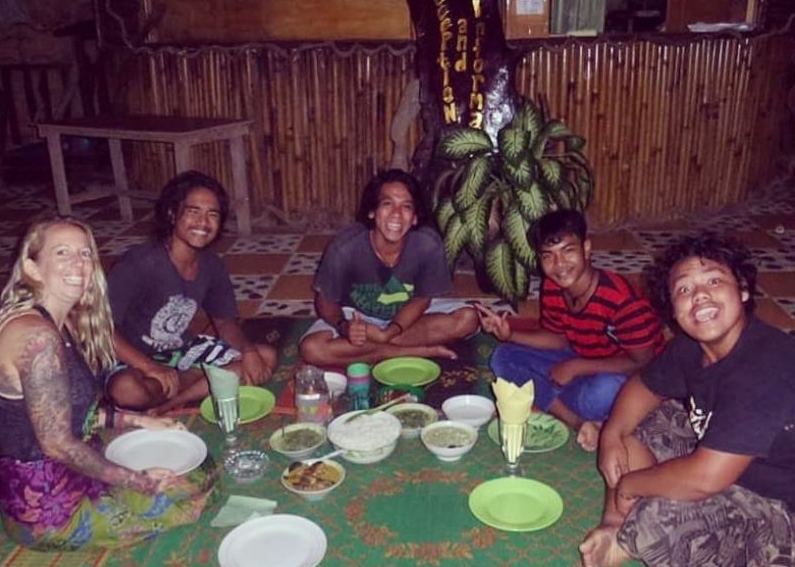
Life is slower-paced; there is plenty of time for family, chatting, enjoying a meal, and snoozing during the hottest part of the day. But when it’s time to work, men and women alike are impressively strong, whether working the land or carving a path through thick jungle.
Sumatrans travel on two wheels. Motorcycle or scooter is the main form of transport, and the smell of smoke is always in the air as people burn their rubbish in the back yard.
Of course, it’s impossible to generalize about life on an island as extensive and diverse as Sumatra. City life is quite different, and there are plenty of areas throughout Sumatra that have funky cafés, thriving music scenes, multi-story malls, and movie theaters.
Before moving to Lake Toba, I spent most of my time travelling and living in Sumatra in a smaller, more remote village, so that’s a side of this place that I adore and love to share.
Sumatra travel advice for solo Sumatra vacations
One of the best things about a solo trip to Indonesia is that the people are so welcoming, warm and friendly, particularly in small villages. Within days of my arrival in various areas, I had been embraced by people and had instant “brothers, sisters, mums, dads, and grandparents.”
People invited me to eat at their homes and showed me around their villages without expecting anything in return. When I fell ill, they shared their traditional medicines with me or drove me to the nearest doctor.
For me, one of the most attractive things about solo travel to Sumatra is that there are very few other international tourists around: in some places, you’ll be the only one.
Most of the time, this is a huge drawcard, as you get a very authentic experience. Also, I’m quite an introvert, so I often enjoy spending my time away from fellow travellers.
This could be a downside for more sociable travellers, however. In some areas, it can be difficult to connect with other tourists, and you may feel relatively isolated.
That’s not to say you’ll never make friends or join someone else when exploring Sumatra. Because there are so few foreigners, it’s very easy to bond with those you do meet. We often see people deciding to travel together or share transport.
Some of the closest friends I have today were fellow travellers I met during my Sumatra travel. This place seems to draw kindred women travelers together.
One thing I would suggest for visitors to Sumatra is to join the Facebook Group Backpacking Sumatra. This is one of the best forums to get information on transport and destinations.
Solo travellers looking to share a Sumatra road trips or transportation often post on this page, and of course, there’s plenty of up-to-date information about things to see in Sumatra, Sumatra safety, getting to Sumatra, Sumatra language, and all other info you might need on your trip to Sumatra.
The other aspect of being one of the few foreigners in an area is the attention you get. As an introvert, I can find it challenging to be the center of attention. You may sometimes be faced with queues of people wanting to take a selfie and chat with you or practice their English.
While people are overwhelmingly warm and welcoming, it can be tiring at times.
Is Sumatra safe to visit for solo female travellers?
Of course, there are hazards in Sumatra, just like any part of the world. As part of the Ring of Fire, earthquakes and volcanic eruptions are a possibility.
Dengue fever is present in some areas, and you may want to consider updating your travel vaccinations before you visit, with particular emphasis on things like rabies and hepatitis vaccines.
Overall, regarding specific safety issues for women, Sumatra is safe, but there are precautions to take.
I prefer to use a recommended private car and driver for most of my journeys over public transport, just for my peace of mind, although I know many solo female travellers who use the local buses with no issues.
In big cities like Medan, stick with Bluebird taxis (they always use a meter and are most trustworthy), or use the Grab or Gojek apps that track your ride.
Keep your valuables secured (no waving expensive cameras around), and avoid wandering around less populated areas alone during the day or night.
Safety in villages is a different story. Generally, you’ll find these are tight-knit communities with families that take care of each other – and their guests. Theft and crime are relatively uncommon.
As for Sumatra religion, around 87% of Sumatra’s population are Muslim, meaning you should consider dressing conservatively. A good general rule throughout most of Sumatra is to keep shoulders, chests, and knees covered.
Some areas are more relaxed, like Tuk Tuk in Lake Toba (where most people are Christian) or tourist villages like Bukit Lawang.
The notable exception is the province of Aceh, where they apply Sharia Law. When travelling in Aceh, you should wear long sleeves and long pants or skirts. A head scarf is not necessary, but you can choose to wear one if you feel more comfortable.

In my experience, men are mostly respectful to foreign women throughout Sumatra, though there are always exceptions. There is something of a misguided belief by some local men that Western women are “loose” and up for anything.
I have been propositioned with various levels of politeness by taxi drivers, customs officers, guides, and random other men over the years, but they are the exception to the rule.
The majority of men I’ve met have taken me under their wing and shown me nothing but respect and camaraderie.
I would recommend solo female travellers to be polite but firm in all situations. If possible, don’t let on to strangers that you are travelling alone. Tell them you’re off to meet a friend or have your husband waiting at your hotel for you. A fake wedding ring can come in handy to avert some unwanted attention.
Use recommended drivers and guides as much as possible, and grab yourself a local SIM card and data (both are very affordable) so you can stay connected with people and reach out if you ever feel unsafe.
Sumatra travel advice
- Always bring cash and carry extra cash. Outside big cities, money changers can be scarce, as can ATMs. Many places don’t accept credit cards, even in touristy areas.
- Bring a phrasebook or use Google Translate. Even better, learn some essential phrases. A surprising number of people speak English, but not everyone, and the effort will be appreciated.
- Prepare for the toilets! A large percentage of bathrooms you visit will have squat toilets and no toilet paper. Some may have a “bum gun” to clean up with; others may have a tub of water with a small bucket to clean and flush with. Bring your own wipes or toilet paper everywhere, with resealable plastic bags. Most times, the local plumbing isn’t designed for toilet paper, so seal your tissues in a baggie and pop them in your bag to dispose of later on.
- Get a local SIM card and data. You’ll need to do this on arrival to Sumatra (or any of the islands of Indonesia). The best option is to grab a tourist SIM at the airport, as they’ll need to register your number and phone with your passport for the card to work. WiFi is common in towns and cities but often unavailable or unreliable in smaller villages.
- It’s polite to take your shoes off before entering homes.
- Try to remember to shake hands, eat, hand over money and so on using your right hand only. The left hand is considered unclean.
- Come prepared for changing weather. It will be hot, but it’s likely to be wet too. Dry bags are a must-have, and a light portable rain poncho. Pack light, quick-drying clothes.
- Bring a sarong – or buy one in you arrive; they are plentiful. These are my essential Sumatra travel item. Use it as a blanket, pillow, scarf, skirt, or towel.
- Never drink tap water, and avoid drinks with ice. Bottled water is your best option here.
- Tips aren’t required but are appreciated. Salaries can be low, so if you are impressed with the service of your guide or driver, even a small tip will go a long way.
If you’d love to visit Sumatra but don’t want to organize everything yourself, these Sumatra tours will do it for you:
➽ Private Full-Day Bukit Lawang Trekking Tour From Medan
➽ 2 days / 1 night Ethical Jungle Trekking
➽ 5 days / 4 nights Medan-Lake Toba-Berastagi Tour
Sumatra FAQ
Where is Sumatra located?
Sumatra is a large island – it compromises the western end of Indonesia. The North Sumatra capital, Medan, is close to Malaysia’s Kuala Lumpur, so this city is a common stop when people travel to Medan, Indonesia.
Is Sumatra safe to travel?
Is Sumatra safe for tourists. It’s very safe. Sumatrans are friendly towards foreigners and crime is rare outside the main cities.
Is Sumatra a good holiday destination?
Absolutely, but only if you’re up for some offbeat travel and can do without modern conveniences. The beauty of Sumatra is its authenticity, and much of it hasn’t succumbed to mass tourism yet.
Is Sumatra worth visiting?
Travel to Sumatra is not a dream vacation for everybody, but if you’re an adventurous soul and enjoy wildlife, it just might be perfect for you! Anybody who enjoys travelling off the beaten path will enjoy Sumatra.
When to visit Sumatra?
The dry season on Sumatra lasts between May and September. Sumatra best time to visit starts in spring, and Sumatra in May is quite pleasant to travel.
How to get to Sumatra?
The easiest way to get to Sumatra is to travel by plane. Your flight will likely land in Medan, the capital of North Sumatra.
How do you travel around Sumatra?
The easiest is by hiring a car with a driver but you can also use public transportation between villages.
Where is Sumatra?
Sumatra is located in Western Indonesia and is part of the Malay Archipelago, between the Malaysian peninsula and the island of Java.
Is Sumatra a country?
No, Sumatra is one of the Sunda Islands of Indonesia. It is Indonesia’s third-largest island after Borneo (shared with Malaysia and Brunei) and the largest, New Guinea (shared with Papua New Guinea).
What is Sumatra known for?
Lush rainforests, active volcanoes, and diverse wildlife (including native orang utans and tigers) are the most celebrated riches of Sumatra. The large island is also known for its cultural diversity and traditional customs.
What is the word Sumatra’s meaning in English?
It’s not completely clear where the word Sumatra comes from. The most popular theory claims it comes from the Sanskrit word “Samudra,” which means “ocean” or “sea,” referencing the island’s coastal location. Another theory suggests that the name could be derived from the Malay words “su” and “matera,” meaning “gold” and “copper”, possibly alluding to the island’s historical associations with precious metal mining.
Guest Contribution by Carly Day. Carly wrote this piece and took the photographs. She is a New Zealand ex-pat now based in Sumatra, Indonesia (her contribution largely uses New Zealand spelling rather than US). After more than a decade of travel in Sumatra, Carly launched a Sumatra travel blog with her Indonesian husband. They now also run the YouTube channel Exploring Sumatra, featuring travel guides and vlogs about daily life in North Sumatra.

